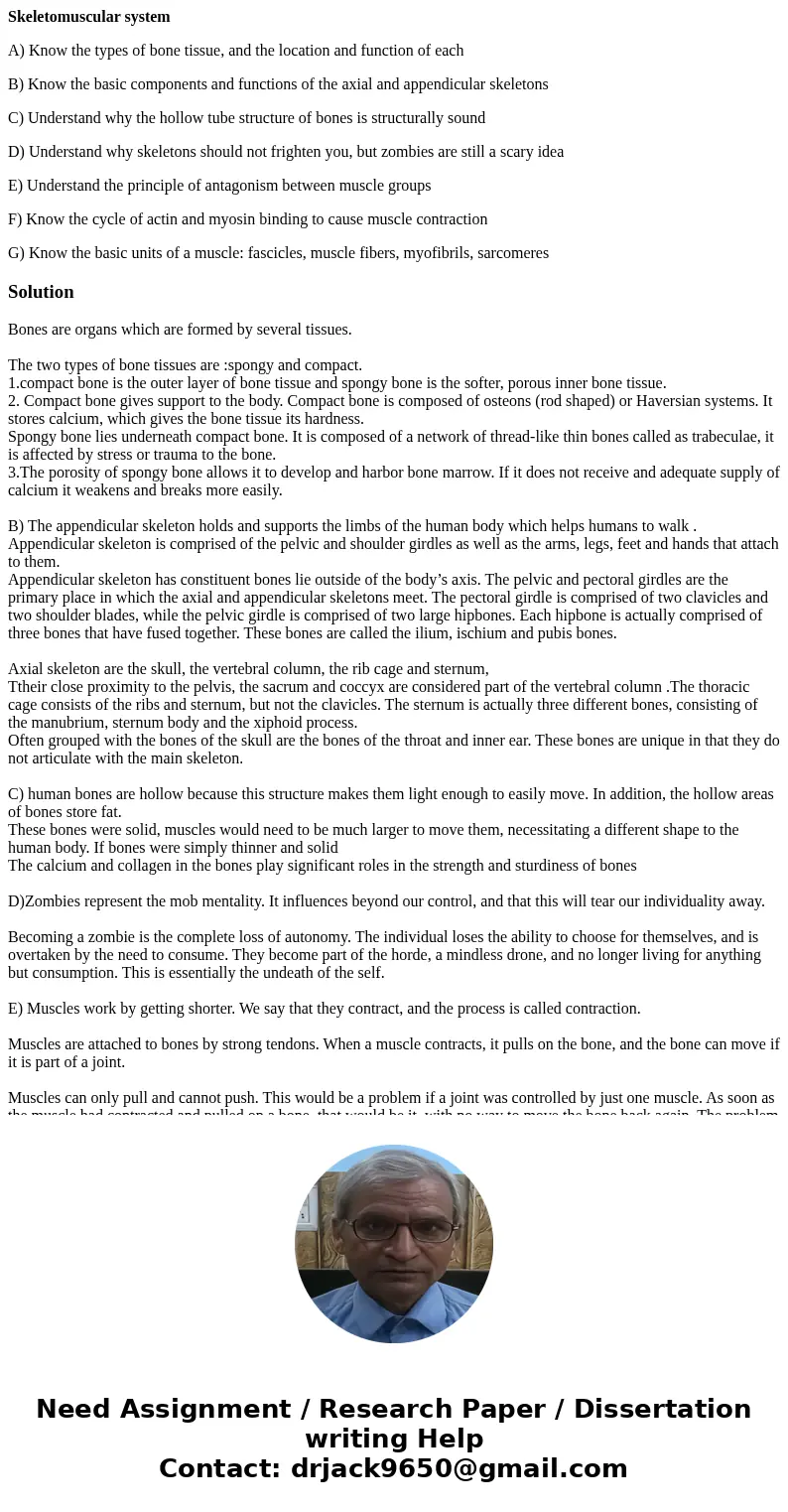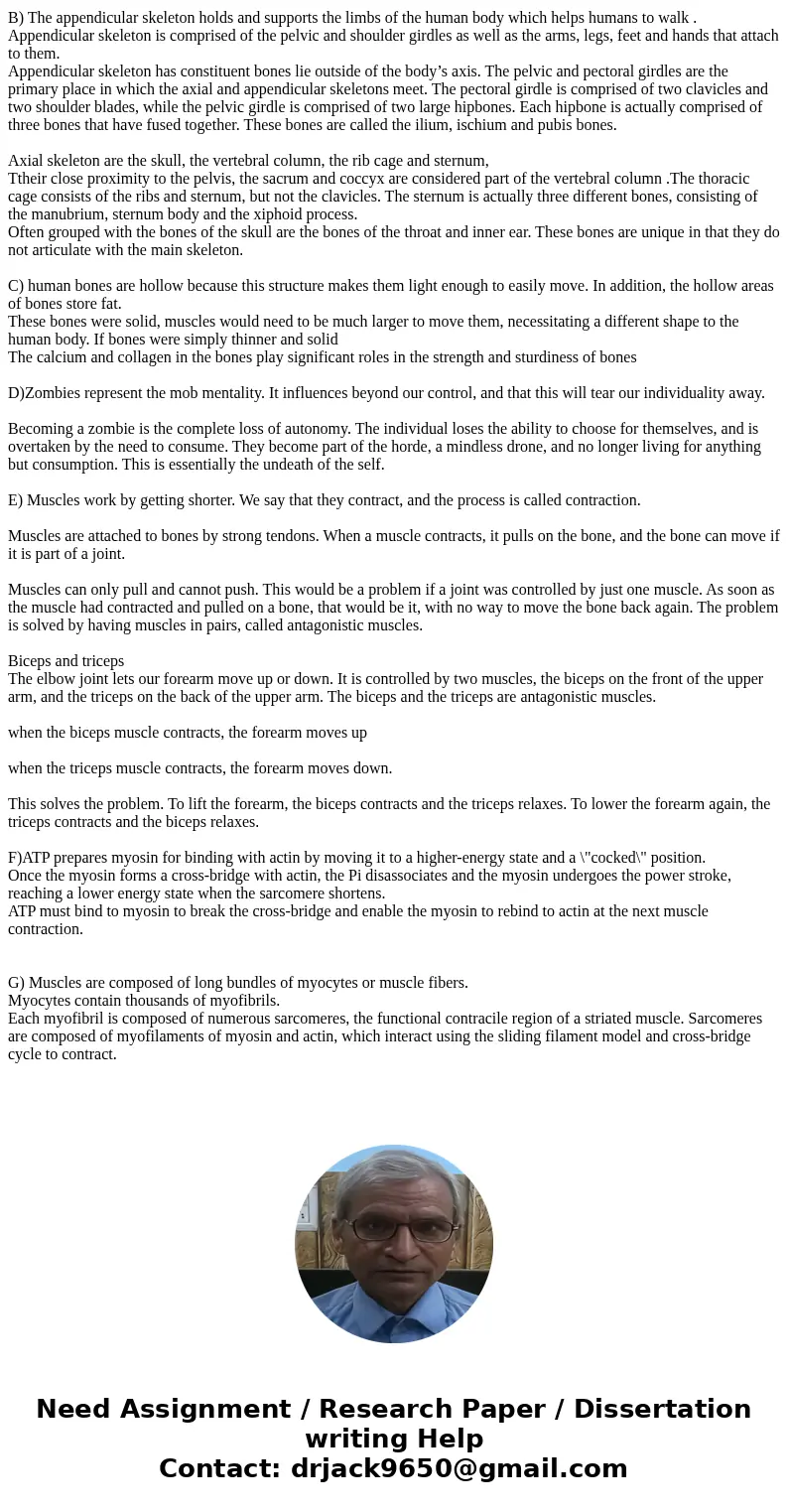Skeletomuscular system A Know the types of bone tissue and t
Skeletomuscular system
A) Know the types of bone tissue, and the location and function of each
B) Know the basic components and functions of the axial and appendicular skeletons
C) Understand why the hollow tube structure of bones is structurally sound
D) Understand why skeletons should not frighten you, but zombies are still a scary idea
E) Understand the principle of antagonism between muscle groups
F) Know the cycle of actin and myosin binding to cause muscle contraction
G) Know the basic units of a muscle: fascicles, muscle fibers, myofibrils, sarcomeres
Solution
Bones are organs which are formed by several tissues.
The two types of bone tissues are :spongy and compact.
1.compact bone is the outer layer of bone tissue and spongy bone is the softer, porous inner bone tissue.
2. Compact bone gives support to the body. Compact bone is composed of osteons (rod shaped) or Haversian systems. It stores calcium, which gives the bone tissue its hardness.
Spongy bone lies underneath compact bone. It is composed of a network of thread-like thin bones called as trabeculae, it is affected by stress or trauma to the bone.
3.The porosity of spongy bone allows it to develop and harbor bone marrow. If it does not receive and adequate supply of calcium it weakens and breaks more easily.
B) The appendicular skeleton holds and supports the limbs of the human body which helps humans to walk . Appendicular skeleton is comprised of the pelvic and shoulder girdles as well as the arms, legs, feet and hands that attach to them.
Appendicular skeleton has constituent bones lie outside of the body’s axis. The pelvic and pectoral girdles are the primary place in which the axial and appendicular skeletons meet. The pectoral girdle is comprised of two clavicles and two shoulder blades, while the pelvic girdle is comprised of two large hipbones. Each hipbone is actually comprised of three bones that have fused together. These bones are called the ilium, ischium and pubis bones.
Axial skeleton are the skull, the vertebral column, the rib cage and sternum,
Ttheir close proximity to the pelvis, the sacrum and coccyx are considered part of the vertebral column .The thoracic cage consists of the ribs and sternum, but not the clavicles. The sternum is actually three different bones, consisting of the manubrium, sternum body and the xiphoid process.
Often grouped with the bones of the skull are the bones of the throat and inner ear. These bones are unique in that they do not articulate with the main skeleton.
C) human bones are hollow because this structure makes them light enough to easily move. In addition, the hollow areas of bones store fat.
These bones were solid, muscles would need to be much larger to move them, necessitating a different shape to the human body. If bones were simply thinner and solid
The calcium and collagen in the bones play significant roles in the strength and sturdiness of bones
D)Zombies represent the mob mentality. It influences beyond our control, and that this will tear our individuality away.
Becoming a zombie is the complete loss of autonomy. The individual loses the ability to choose for themselves, and is overtaken by the need to consume. They become part of the horde, a mindless drone, and no longer living for anything but consumption. This is essentially the undeath of the self.
E) Muscles work by getting shorter. We say that they contract, and the process is called contraction.
Muscles are attached to bones by strong tendons. When a muscle contracts, it pulls on the bone, and the bone can move if it is part of a joint.
Muscles can only pull and cannot push. This would be a problem if a joint was controlled by just one muscle. As soon as the muscle had contracted and pulled on a bone, that would be it, with no way to move the bone back again. The problem is solved by having muscles in pairs, called antagonistic muscles.
Biceps and triceps
The elbow joint lets our forearm move up or down. It is controlled by two muscles, the biceps on the front of the upper arm, and the triceps on the back of the upper arm. The biceps and the triceps are antagonistic muscles.
when the biceps muscle contracts, the forearm moves up
when the triceps muscle contracts, the forearm moves down.
This solves the problem. To lift the forearm, the biceps contracts and the triceps relaxes. To lower the forearm again, the triceps contracts and the biceps relaxes.
F)ATP prepares myosin for binding with actin by moving it to a higher-energy state and a \"cocked\" position.
Once the myosin forms a cross-bridge with actin, the Pi disassociates and the myosin undergoes the power stroke, reaching a lower energy state when the sarcomere shortens.
ATP must bind to myosin to break the cross-bridge and enable the myosin to rebind to actin at the next muscle contraction.
G) Muscles are composed of long bundles of myocytes or muscle fibers.
Myocytes contain thousands of myofibrils.
Each myofibril is composed of numerous sarcomeres, the functional contracile region of a striated muscle. Sarcomeres are composed of myofilaments of myosin and actin, which interact using the sliding filament model and cross-bridge cycle to contract.


 Homework Sourse
Homework Sourse